Address any questions or comments regarding this newsletter to the individual authors listed after each article or to its editors, Nathan Johanning, 618-939-3434, njohann@illinois.edu or Bronwyn Aly 618-695-6060, baly@illinois.edu. The Illinois Fruit and Vegetable News is available on the web at: http://ipm.illinois.edu/ifvn/. To receive or be removed from email notification of new postings of this newsletter, contact Nathan Johanning or Bronwyn Aly at the phone numbers or email addresses above.
In This Issue:
Upcoming Programs ((listings for beginning and established growers))
News & Announcements ((FDA Publishes Final Rule Extending Compliance Dates for Agricultural Water Provisions))
Regional Reports ((west central, Dixon Springs))
Fruit and Vegetable Pest Management (( Modified Growing Degree Days from Jan 1 through March 18, Brown Marmorated Stink Bug Management and Research Discussed in Recent Article from Good Fruit Grower, Spotted Lanternfly Webinars Now Posted ))
Upcoming Programs
Check the Illinois SARE calendar for a full list of programs and links for registration.
http://illinoissare.org/ and http://illinoissare.org/calendar.php
Also see the University of Illinois Extension Local Food Systems and Small Farms Team’s website at:
http://web.extension.illinois.edu/smallfarm/ and the calendar of events at http://web.extension.illinois.edu/units/calendar.cfm?UnitID=629.
- 2019 Small Farms Winter Webinar Series, Thursdays at noon, from January 24 –April 4, 2019.
Registration is open for the 2019 series with a whole new set of topics! It’s easy (and FREE!) to register for the Small Farms Winter Webinars. Sign up for as many as you want at https://go.aces.illinois.edu/SmallFarmWinterWebinar. We’ll send you a webinar reminder, log-on instructions, and how to access the archived recording. If you do not have broadband internet capable of streaming video, call your local Extension office to see if they can offer live viewing.
Topics for this year’s series are:
Mar. 28 Agroforestry for Diversification on Small Scale Farms- Bill Davison, University of Illinois Extension Local Food Systems and Small Farms Educator
Apr. 4 ABCs of Tomato Production
- Bronwyn Aly, University of Illinois Extension Local Food Systems and Small Farms Educator
- Produce Safety Alliance Grower Training, April 12, 2019, University of Illinois Extension Office, 818 S. Park, Hardin, IL 62047. Do you have concerns about safety in your produce operation? Are you concerned whether you need to comply with the Food Safety Modernization Act Produce Rule? Do you want to know more about the difference between FSMA and GAPs? Then the Produce Safety Alliance Grower Training might be for you! For more information or to register (by April 1): https://go.illinois.edu/PSAHardin2019 The PSA Grower Training Course is one way to satisfy the FSMA Produce Safety Rule requirement outlined in § 112.22(c) that requires ‘At least one supervisor or responsible party for your farm must have successfully completed food safety training at least equivalent to that received under standardized curriculum recognized as adequate by the Food and Drug Administration.’ In addition to learning about produce safety best practices, key parts of the FSMA Produce Safety Rule requirements are outlined within each module. There will be time for questions and discussion, so participants should come prepared to share their experiences and produce safety questions. Costs ($75.00) include PSA Grower Training Manuals, handouts, AFDO Certificate of Course Attendance, and lunch. Certificates are required for individuals looking to meet the conditions of the FSMA Produce Rule. Questions can be directed to Laurie George at (618) 242-0780 or at ljgeorge@illinois.edu.
News & Announcements
FDA Food Safety Modernization Act (FSMA)
FDA Publishes Final Rule Extending Compliance Dates for Agricultural Water Provisions
March 15, 2019
Today, the U.S. Food and Drug Administration issued a rule to finalize the new compliance dates for the agricultural water requirements in the FDA Food Safety Modernization Act (FSMA) Produce Safety Rule.
Larger farms are now required to comply with the agricultural water requirements by January 26, 2022, while small farms have until January 26, 2023 and very small farms until January 26, 2024. This rule does not change the compliance dates for sprout operations.
These compliance dates have been extended while the FDA considers how best to protect public health while addressing widespread concerns about the complexity of the agricultural water requirements and the practicality of implementing them across a wide variety of farms, water sources and uses. The FDA intends to use this time to work with stakeholders to address these concerns.
While this rule extends the compliance dates for the agricultural water provisions, produce remains subject to the other provisions of the Produce Safety Rule and the adulteration provisions of the Federal Food, Drug and Cosmetic Act (FD&C Act).
For More Information:
- Constituent Update
- Final Rule: Standards for Growing, Harvesting, Packing and Holding of Produce for Human Consumption; Extension of Compliance Dates for Subpart
- FSMA Final Rule on Produce Safety
Laurie George (618-548-1446; ljgeorge@illinois.edu )
Regional Reports
From west central Illinois... Our soils are flush with water after the snowmelt and rains we’ve received recently. How swollen are the soils? Well, we have a bar running above one of the gates into our garden, to dissuade deer from jumping over our four-foot gates. Usually, I can walk underneath, no problem. Today I cracked my head on the bar. I am also regretting not bringing my boots to work today. More rain and warmer temperatures are in the forecast this coming week.
Growers have planted cool season crops of many different types. Row cover or low tunnel protects those planted in the field during cold snaps. Tomatoes are being planted into high tunnels. Warm season crops meant to be planted in the field, are occupying flats in greenhouses or growers basements under grow lights across the area, waiting for those frost-free dates. Indeed the growing season for many has begun.
My over-wintered crops of spinach and carrots made it through our polar vortexes and blizzards just fine. I harvested all my carrots today (March 20), as I can see the hints of new growth at their crowns. In the past, when new growth emerges from over-wintered carrots, the carrots begin to lose their flavor and sometimes split. After digging, I tasted a few carrots, and they are just as sweet as the January ones. If you have an early spring market (or winter markets) this is a great crop. The spinach has put on enough growth for harvest. Again, winter spinach is something to consider if you are selling year-round. My bed with the kale lost the plastic cover and had just a layer of row cover for protection during one of our coldest nights. Not much remains there.
Early this week the weather cooperated to replace the top on a high tunnel in Knox County. The grower had a tear form down the middle of the plastic during a windstorm this past fall. It was great to get out and pull some plastic!
On March 1, I began the process to pre-sprout my ginger root. Over the weeks, I have observed the growing points on the rhizomes swell. Today, March 20, I checked the flat and small shoots have begun to emerge! This will be year three for growing ginger and turmeric. In the past, I have planted ginger in-ground. After throwing an extra ginger plant in a pot last year, I was delighted at the results of bag culture. This year I will plant more grow bags of ginger and compare that to the in-ground plants. I dipped into my stock a couple of times over the winter to add some ginger flavor to some meals. Even if you just grow one pot of this stuff for yourself, it is worth it in the cold winter.
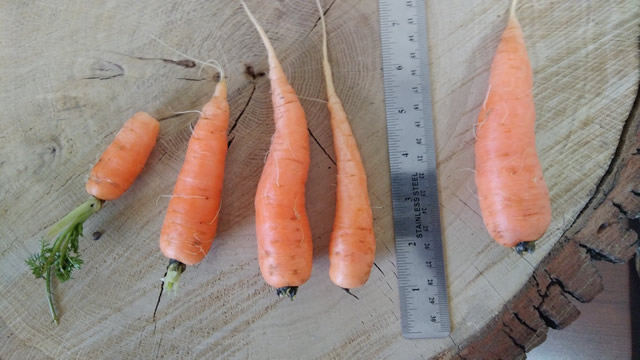
Over-wintered carrots harvested the first day of spring in 2019. New growth is emerging so it is time to get these plants out of the ground. Photo by Chris Enroth.
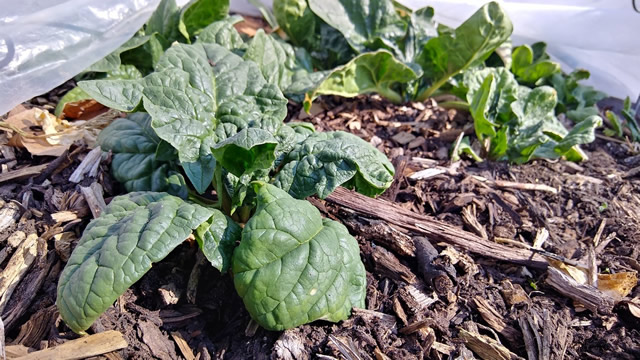
Over-wintered spinach ready for a cut. Some of the leaves a have a little frost damage on their margins. The new growth these past few weeks has been perfect. Photo by Chris Enroth.
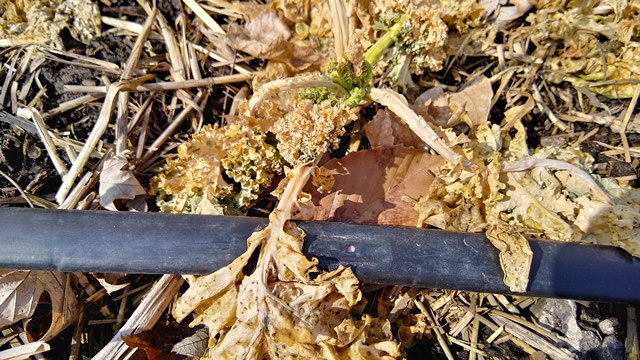
The kale didn’t make it through the winter. The plant is still alive and likely there will be new growth coming up, but these plants will be culled. Photo by Chris Enroth.

Our wash shed stood strong through blizzards, but last week’s day of high wind toppled it. Photo by Chris Enroth.
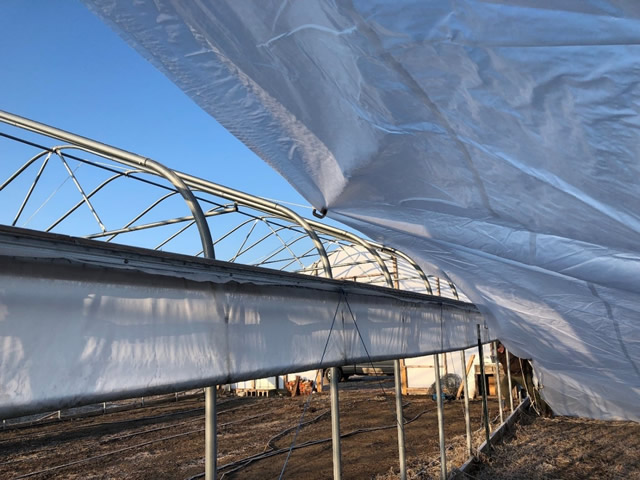
Pulling the new top on the high tunnel. Photo by Dusty Spurgeon
Chris Enroth (309-837-3939; cenroth@illinois.edu
From Dixon Springs Ag Center…We have been anxious to get the 2019 growing season underway and have worked over the last couple of weeks to get some things planted in the high tunnels. The March winds have definitely been expressing themselves these last couple of weeks. We were able to pull new plastic on the Farmtek tunnel on March 8, but the wind picked up in the middle of the process and made it very challenging to get a tight stretch across the top. The first photo below shows the inside of the Farmtek tunnel with row cover over a row of cucumbers next to a row covered in a black plastic tarp. We are in the process of steaming the beds. The cucumber row was steamed on March 18, with cucumber planting following on March 19. The remaining beds in this tunnel are in various stages of amendment and working prior to steaming and planting. Perlite from last year’s hydroponic crops was spread out over the beds and the beds have been top dressed with compost. Beds are tilled in with our mini culitvator that fits nicely between the boards on the sides of the raised beds (the third row).
‘Monterey’ strawberry plants were transplanted into the vertical stacks inside the hydroponic tunnel on March 11. New growth can be seen as well as the first flower buds. Grafted cucumber transplanted were also planted in the hydroponic tunnel on March 19. Cucumbers planted in both the hydroponic and the Farmtek (raised bed, in ground production) tunnels are part of the grafted cucumber research trial being conducted by Dr. Wenjing Guan, Purdue University. DSAC is one of several locations participating in this research trial. Dr. Guan grafted the plants at her facility in Vincennes, IN and delivered transplants to us on March 14.
We did have to do a bit of greenhouse repair after the winds on the night of March 14. A couple of roof panels blew out and needed to be replaced. It also appears that the rolling doors that close the south end of the hydroponic tunnel are now bent near the track. Never a dull moment and you never know which hat you will need to wear.
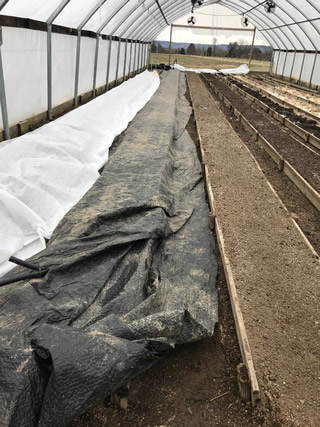
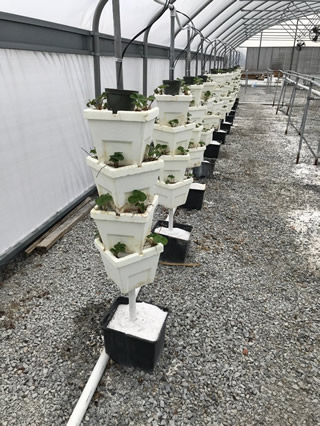
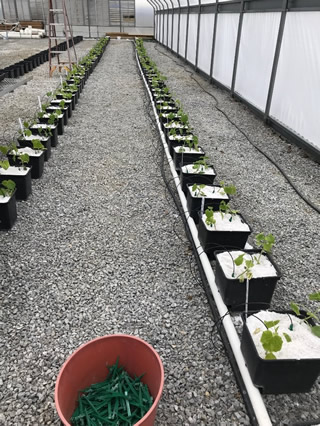
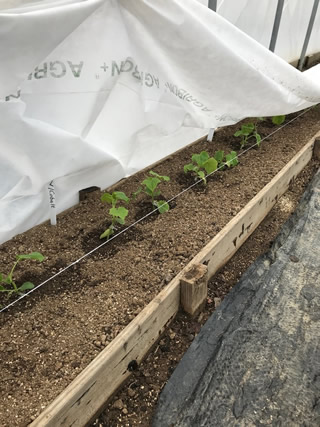
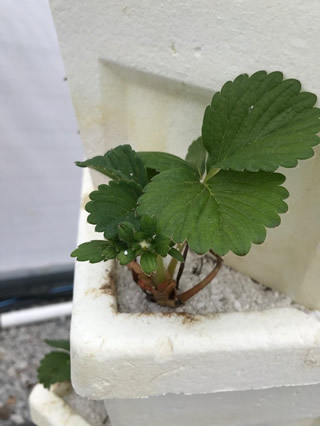
Photos by Bronwyn Aly.Bronwyn Aly (618-382-2662; baly@illinois.edu)
Fruit and Vegetable Pest Management
Modified Growing Degree Days (Base 50⁰ F, January 1 through March 18)
Station Location |
Actual Total |
Historical Average |
One- Week Projection |
Two-Week Projection |
Freeport |
4 |
15 |
12 |
27 |
St. Charles |
8 |
17 |
16 |
32 |
DeKalb |
4 |
18 |
15 |
33 |
Stelle |
10 |
28 |
22 |
43 |
Peoria |
14 |
37 |
29 |
52 |
Monmouth |
8 |
31 |
21 |
43 |
Champaign |
19 |
40 |
34 |
55 |
Springfield |
27 |
47 |
45 |
69 |
Perry |
24 |
56 |
42 |
69 |
Brownstown |
39 |
72 |
60 |
88 |
Olney |
45 |
69 |
66 |
92 |
Belleville |
56 |
87 |
79 |
110 |
Rend Lake |
58 |
92 |
84 |
117 |
Carbondale |
77 |
97 |
101 |
135 |
Dixon Springs |
102 |
113 |
130 |
166 |
Insect development is temperature dependent. We can use degree days to help predict insect emergence and activity. Degree day accumulations calculated using the Pest Degree-Day Calculator
Kelly Estes (217-333-1005; kcook8@illinois.edu)
Brown Marmorated Stink Bug Management And Research Discussed In Recent Article From Good Fruit Grower
While brown marmorated stink bug populations are not near the levels seen previously in the Northeastern US orchards, this is an insect pest that does make its presence known in Illinois. A recent article from Good Fruit Grower (https://www.goodfruit.com/raising-a-stink-for-bmsb-research/) discusses current research on managing this pest, including updated traps, attract-and-kill strategies, and biocontrol.
As a reminder, brown marmorated stink bug is found in many areas in Illinois. Counties indicated in Figure 1 have submitted a photo or specimen for official confirmation to Kelly Estes, Illinois Pest Survey (kcook8@illinois.edu).

Figure 1. Counties with confirmed detections of brown marmorated stink bug in Illinois.Kelly Estes (217-333-1005; kcook8@illinois.edu)
Spotted Lanternfly Webinars Now Posted
In late February and early March, the Northeastern IPM Center hosted several webinars with updates on the spotted lanternfly. The series provided updates on what we know about this invasive in the northeast. While the spotted lanternfly has not been detected in Illinois, it is an excellent hitchhiker and moves primarily through human movement.
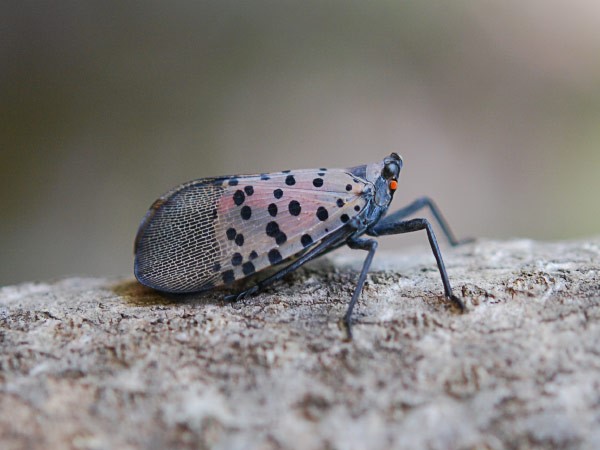
Figure 1. An adult spotted lanternfly on Ailanthus altissima in Berks County, Pennsylvania. Photo by Lawrence Barringer, Pennsylvania Department of Agriculture, Bugwood.org
- Overview of spotted lanternfly biology and identification
- Overview of hosts
- Monitoring and management strategies
- Regulatory update
While the content may be relevant to audiences throughout the Northeast (and helpful to us in the Midwest), management practices covered are specific to New York.
Spotted Lanternfly Basics for Hops, Berry, and Vegetable GrowersSpotted Lanternfly Basics for Grape and Apple Industries
Spotted Lanternfly Basics for Christmas Tree Growers
Spotted Lanternfly Basics for Nursery, Greenhouse, and Landscape Industries
This insect has not been found in Illinois. If you suspect the spotted lanternfly, please contact the Illinois Department of Agriculture at (815) 787-5476 or take a photo and send a detailed email to: lanternfly@illinois.edu including when, where, and specifics of the location.
Kelly Estes (217-333-1005; kcook8@illinois.edu)
Less Seriously
Hardships often prepare ordinary people for an extraordinary destiny. – C.S. Lewis
Believe in yourself. You are braver than you think, more talented than you know, and capable of more than you imagine. ― Roy T. Bennett
If you believe it will work out, you’ll see opportunities. If you believe it won’t, you will see obstacles. – Wayne Dyer
Hard times don’t create heroes. It is during the hard times when the ‘hero’ within us is revealed. – Bob Riley
Remember that not getting what you want is sometimes a wonderful stroke of luck. —Dalai Lama
University of Illinois Extension Specialists in Fruit and Vegetable Production & Pest Management
Extension Educators – Local Food Systems and Small Farms |
||
Bronwyn Aly, Gallatin, Hamilton, Hardin, Pope, Saline, and White counties |
618-382-2662 |
|
Katie Bell, Franklin, Jackson, Perry, Randolph, & Williamson counties |
618-687-1727 |
|
Sarah Farley, Lake & McHenry counties |
847-223-8627 |
|
Nick Frillman, Woodford, Livingston, & McLean counties |
309-663-8306 |
|
Laurie George, Bond, Clinton, Jefferson, Marion, & Washington counties |
618-548-1446 |
|
Zachary Grant, Cook County | 708-679-6889 | |
Doug Gucker, DeWitt, Macon, and Piatt counties |
217-877-6042 |
|
Erin Harper, Champaign, Ford, Iroquois, and Vermillion counties |
217-333-7672 |
|
Grace Margherio, Jackie Joyner-Kersee Center, St. Clair County |
217-244-3547 |
|
Grant McCarty, Jo Daviess, Stephenson, and Winnebago counties |
815-235-4125 |
|
Katie Parker, Adams, Brown, Hancock, Pike and Schuyler counties |
217-223-8380 |
|
Kathryn Pereira, Cook County |
773-233-2900 |
|
James Theuri, Grundy, Kankakee, and Will counties |
815-933-8337 |
|
Extension Educators – Horticulture |
||
Chris Enroth, Henderson, Knox, McDonough, and Warren counties |
309-837-3939 |
|
Richard Hentschel, DuPage, Kane, and Kendall counties |
630-584-6166 |
|
Andrew Holsinger, Christian, Jersey, Macoupin, & Montgomery counties |
217-532-3941 |
|
Extension Educators - Commercial Agriculture |
||
Elizabeth Wahle, Fruit & Vegetable Production |
618-344-4230 |
|
Nathan Johanning, Madison, Monroe & St. Clair counties |
618-939-3434 |
|
Campus-based Extension Specialists |
||
Kacie Athey, Entomology |
217-244-9916 |
|
Mohammad Babadoost, Plant Pathology |
217-333-1523 |
|